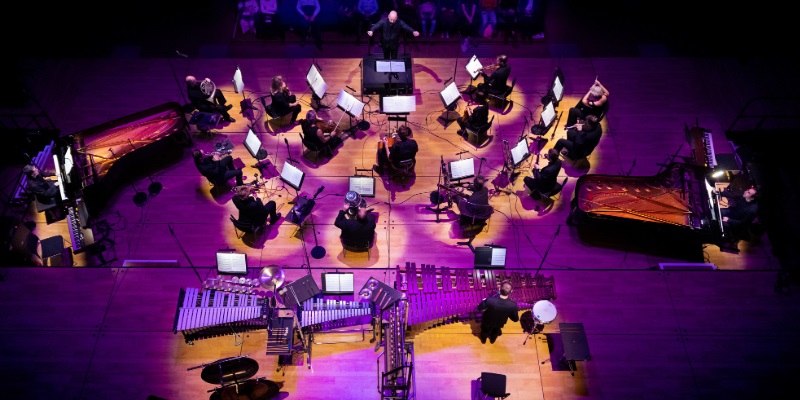
YorkConcerts presents Ensemble Intercontemporain, Sir Jack Lyons Concert Hall, University of York, April 17
ON Wednesday evening, the Rolls-Royce of contemporary music performers, Ensemble Intercontemporain, performed an extraordinary programme of music by Martin Suckling, Thomas Simaku and Olivier Messiaen.
The concert opened with Martin Suckling’s Visiones (after Goya), an inspired response to a specific drawing from Goya’s unique, if somewhat unsettling, Witches and Old Women Album. The Visiones depicts an intimate dance between a possibly inebriated old couple with another chap looking on, or rather on the floor looking up. The image seems to have an uncomfortable erotic edge, perhaps sex in old age.
Anyway, to Mr Suckling’s work. In response to the Goya sketch, Visiones (after Goya) has three instrumentalists, cello, clarinet and piano, and three sections. In the first part, the clarinet and cello dance, serenade each other in ‘repeated microtonal lyrics’.
The percussive piano creates distance and commentary. The effect is very distinct, haunting and not a little spooky. Yet there is intimacy and it is this, as well as the superb playing by Martin Adámek (clarinet) and Renaud Déjardin (cello), that draws you into this sound world.
There is also a genuine warmth of engagement. This is particularly obvious in the second section ‘lullaby’ before the dance becomes ritualistic. The third section is a kind of distorted recapitulation; a memory, a nightmare. Maybe.
The piano (the imperious Dimitri Vassilakis) now sings the song, the clarinet has the role of ‘soft multiphonics’ commentary whilst the cello lets rip to very dramatic effect. The dance returns but now transformed. To be sure the piece was, like the Goya, unsettling. But it was true to the artist’s multi-layered complexity, and beauty. The performance was illuminating.
I had a bit of an issue with a2(b) for violin and cello by Thomas Simaku; not with the forceful piece itself, nor with the thrilling performance by soloists Jeanne-Marie Conquer (violin) and Renaud Déjardin (cello), but with the extensive programme note.
OK, the instrumental explanation of a2 (a due) was fine; it made perfect sense. However, the dramatisation of opposites – a response to the ‘remnants of the wall in Bernauer Strasse’, a tale of contrasting cities, of brutally conflicting ideologies representing oppression and freedom in 1945 Berlin – did not.
To be fair to the composer, he clearly stated that the musical and extramusical could not be separated; they are two aspects of the same song. But for me the piece did not (and could not) deliver an image of complete opposites: because the most striking and distinguished aspect of Simaku’s music is its mastery of an organic, cellular and uniform musical language. The uncompromising, almost violent, gestures and mood swings worked perfectly well on and in their own terms.
However, the piece was jaw-droppingly good and technically seriously accomplished. I thought the fast, driving conclusion with its spent, exhausted epilogue was very effective indeed. The performers were on top of their game, and they needed to be.
Just one minor whinge before the interval: what was it with the photographer taking shots from the back of the auditorium? It was distracting and utterly unnecessary.
After the interval we were treated to the most illuminating performance of Messiaen’s Quartet For The End Of Time. For what it’s worth, the balance of the opening Crystal liturgy didn’t seem quite even, but given the quality of performers and the excellent acoustic, this is more likely due to my ears waking up again after the 20-minute break.
The second movement Vocalise, for the Angel who announces the end of time, was sublime. The control needed and delivered by clarinettist Martin Adámek was extraordinary. The effect was otherworldly, visionary; beautiful, delicate but definitely bleak.
The Interlude was an utter, quirky delight. Were there echoes of Shostakovich? I thought so. Possibly. Renaud Déjardin and Dimitri Vassilakis’s performance of Praise To The Eternity Of Jesus was the best live version I have heard.
Nothing quite prepares you for this experience; it was so hypnotic, so compelling. I think this is due to the piano ‘accompaniment’ which came across so powerfully. At first, a pulse, a heartbeat, gradually driving the cello song with almost hammer-like intensity before they melt into ecstasy, resolution. Quite extraordinary.
The Dance Of Fury, for the seven trumpets, was technically perfect. It delivered a unity of purpose and energy. Edge-of-the-seat stuff. The penultimate Tangle Of Rainbows…was brimming with physicality. It both looked back, specifically to the second Vocalise, as well as to the future and the final movement in particular. The performance of Praise To The Immortality Of Jesus, was simply divine.
Review by Steve Crowther
